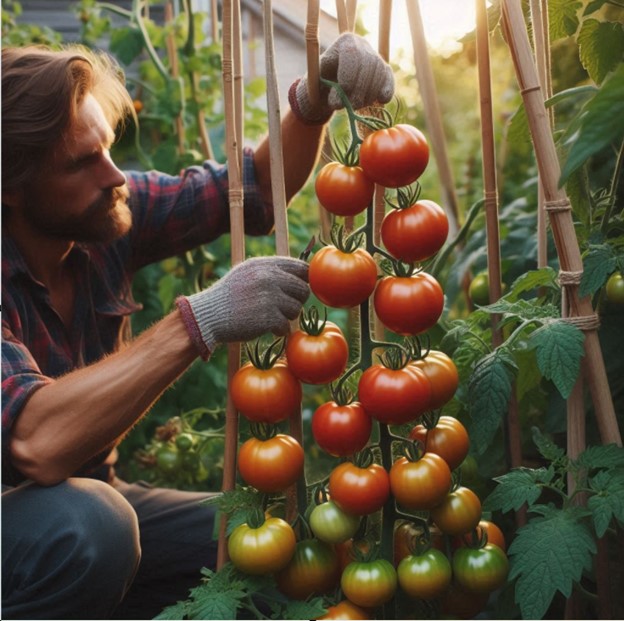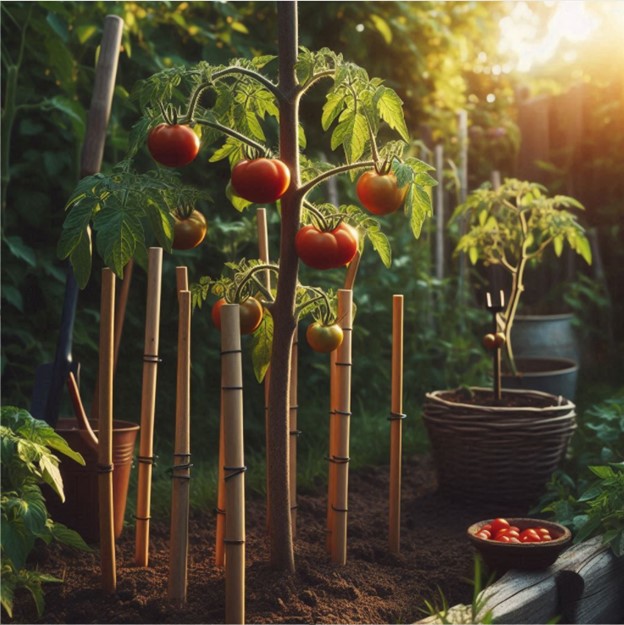Staking is an easy way to support tomatoes and help them grow tall and strong. It also helps to keep the garden organized and, in turn, boosts productivity.
Using the right techniques and tools, you can give your tomato plants the much-needed support to thrive and ensure a bountiful harvest.
So, grab the stakes and twine, wear your gardening gloves, and let us explore the art of staking tomatoes in this comprehensive guide.
When To Stake And Weave Tomato Plants?
Table of Contents

The ideal time for staking tomatoes is when they are 6-12 inches tall and almost 2-3 weeks after they are transplanted outside. Doing this will allow tomatoes to grow around the support structure naturally.
If the plants are staked early, they will have enough time to grow, and they will be easy to manage without causing any damage.
If you do not stake at the planting time, the next best time is during the early growth stage, when the plants are small and the root system is limited.
Why Should You Use The Stake Method?

There are several reasons why staking tomatoes is a good idea, and those are cited below:
- Reducing Disease
- Improving The Fruit Quality
- Space Efficiency
- Easy Maintenance
- Increasing Yield
- Improved Air Circulation
- Better Exposure To Sunlight
- Protection From Rot
- Easy Harvesting
- Improved Plant Structure
- Less Accessible To Pests And Insects
- Better Pruning
Ways To Stake Tomato Plants

This step-by-step guide will ensure healthy growth alongside abundant harvests. Read through this guide to learn How To Take Care Of A Tomato Plant.
Here’s how you can stake your tomato plants effectively:
Materials:

- Stakes (wooden, metal or bamboo)
- Soft Ties (garden twine, cloth strips, or specialized plant ties)
- Hammer or Mallet
- Gloves
Procedure:
Step -1:
Choose the right stakes that should be at least 6 feet tall.
Step -2:
Install the stakes at the time of planting and position the stakes about 2-3 inches away from the plant.
Step -3:
Insert the Stake into the ground and ensure the stake is at least 12 inches deep.
Step -4:
Tie the Plant to the stake using a soft tie. The tie should be firm enough to support the plant but loose enough to allow growth.
Step -5:
Ensure additional ties every 8-12 inches as the plant grows taller. Make necessary adjustments to facilitate plant growth.
Step -6:
Regular pruning and monitoring the ties or adding new ones encourages plant growth and produces more.
Different Ways To Stake Tomatoes
The different methods of staking a tomato plant are discussed below:
1. Tomato Cages
Tomato cages are specifically designed to support tomato plants as they grow. They are known to provide the necessary support to keep the plants upright and also prevent branches and fruits from sagging.
2. Wooden Stake
Wooden Staking is another popular method for tomato support in the home garden. It provides stability and promotes healthy growth. Sturdy wooden stakes are required to hold the plants upright.
3. String Trellis
String Trellis is generally used in small or vertical gardens. A support structure with strings or twine is required to help the plants grow upright.
4. Fence Panel
The Fence Panel method of supporting the tomato plants is effective if you have a more extensive garden or are looking forward to growing multiple plants in a row. The robust framework is suitable for handling the weight of mature tomato plants.
5. Florida Weave
In this case, the tomato plants are staked using stakes and twine to create a support structure that will hold the plant upright. This practical and efficient method of staking tomatoes provides a rewarding experience.
Benefits Of Staking A Tomato Plant

Staking tomato plants provides a bounty of benefits, and here’s a breakdown of the same:
- Staking helps in preventing diseases and keeps the fruit free from rot.
- Also, staking tomatoes increases the production by twice or thrice.
- Improves air circulation around the plants.
- It allows better pruning and helps to balance the top-heaviness of the plant.
- Staking supports the weight of the tomatoes and will enable them to grow larger.
- When it comes to harvesting tomatoes, staked tomatoes are more accessible to reach and harvest.
- It is beneficial for gardeners who have limited space.
- Staking improves the plant structure and reduces the risk of damage from wind or other environmental issues.
Final Words
So, follow the steps outlined above and provide your tomato plants with the support they need to produce a bountiful yield.
It doesn’t matter which staking method you choose; the main objective is to provide strong support to the plant so that it grows upright.
Leave a Reply